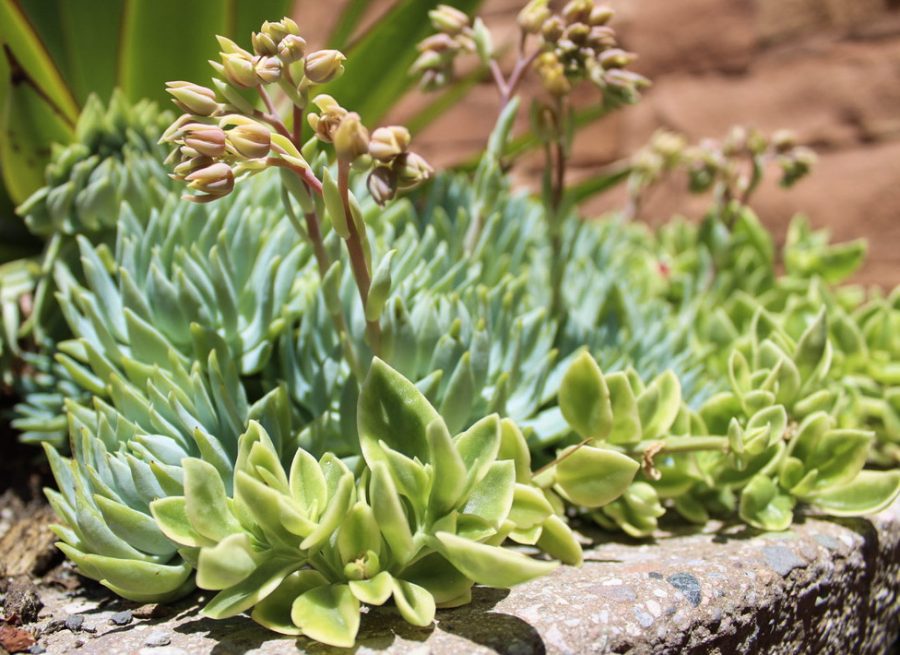Cowley: Rip Out Your Lawns
The Water Conservation section at Red Butte Garden displays a variety of plants that thrive in Utah’s dry climate on Friday, July 2, 2021 (Photo by Brooklyn Critchley | The Daily Utah Chronicle)
February 5, 2022
I have never lived in a place that didn’t experience some stage of drought. As a person living in a metro area, it’s hard to wrap my head around the damages of prolonged droughts, not only to the environment but to the people around me. Often, people who understand the effects of climate change and drought feel helpless and don’t know what they can do to help. Using satellite imaging, NASA estimates that the U.S. alone has around 40 million acres of lawn. Many may not know that these lawns can actually damage the environment because of their maintenance, especially in dry climates like Utah. Individuals can replace lawns with xeriscaping to help combat the drought in Utah.
Utah’s drought has affected every aspect of the state. 100% of the state currently experiences drought, with 31.8% experiencing extreme drought. The lack of water has reduced the number of deer and other big game species, as newborn fawns are less likely to survive their first year. Fish are affected too, as lower water levels and higher temperatures cause them to stress and make them more likely to die.
Due to less moisture in vegetation and the soil, wildfires have also become more and more common. In July 2021, 351 wildfires were reported in a single month. The low moisture content in the soil not only contributes to wildfires but can make farming difficult. Some Utah farmers reported that they can only plant as little as 10% of their acreage due to a lack of water in 2021.
Drought also affects Utah’s snowfall. A small snowpack not only can close skiing and snowboarding down early but also decreases stream levels and soil moisture content, prolonging the drought even further.
Lawns may seem harmless compared to these impacts of the drought, but quite the opposite is true. On average, an American family uses 320 gallons of water a day. Thirty percent of that goes solely to lawn maintenance. In dry climates like Utah, lawns can take up 60% of a family’s outdoor water usage. The amount of water used on lawns prompted Gov. Spencer Cox’s statewide lawn buyback program to incentivize Utahns to tear out their lawns.
Not only do lawns use an exorbitant amount of water, but the fertilizer used in lawn care creates problems as well. Lawn fertilizer contributes to algal blooms, which pose problems to wildlife and humans alike. Cyanobacteria caused by algal blooms frequently appear in Utah Lake, which can cause stomach problems, skin rashes and runny noses. In areas with low water levels, pollution in the water becomes more concentrated. This not only harms the humans drinking it but can kill off the native fish population as well.
On top of all that, lawns take away space for native biodiversity. Many pollinators rely on native plants to sustain themselves, and since lawns aren’t native to Utah, it becomes harder for them to find food sources. This contributes to the decline of pollinators in a given area.
Losing your lawn not only reduces the amount of water the state uses but can also promote biodiversity. Xeriscaping is the process of landscaping with drought-resistant, native plants. Taking out your lawn and xeriscaping instead can save an estimated 5,000 to 8,000 gallons of water a year. Not only that, but xeriscaping reduces the need for fertilizer and the time needed to maintain a backyard and helps native pollinators flourish.
While the price of converting to xeriscaping comes out to $1.50 to $2.50 per square foot, the average household can save 36 cents per square foot per year due to the lower amount of maintenance needed. Xeriscaping not only provides the most environmentally friendly option but can also save money in the long run.
Being at the mercy of a drought can be harrowing, but finding ways that individuals can minimize the effects can be empowering. The summer of 2021 proved that the effects of prolonged drought are disastrous. If reducing our personal water consumption can make a difference, the conscientious thing to do is to rip out our lawns — not only for yourself but for your community as well.









Susan Jensen • Feb 6, 2022 at 9:17 pm
I learned several new things about water conservation and the importance of changing our way of landscaping. Thank you.